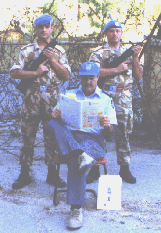
Figure 1. A 1995 85321 student studying in Cyprus
Abstract
Traditional university education, in both on-campus and distance education modes, suffers from a number of problems (Laurillard, 1993; Jones, 1996). This paper describes an attempt to address these problems using a collaborative, on-line teaching method within the subject 85321 Systems Administration offered by the Department of Mathematics and Computing at Central Queensland University (CQU). Outlining the problems suffered by university education, the paper describes the way students and teachers demonstrated that this subject is a perfect candidate for on-line education. The paper discusses the design and implementation of the teaching method, including an examination of the tools developed to implement the learning approach and the conclusions based on the experience and early student feedback.
Both on-campus and distance students at CQU take 85321. In 1996, 85321 was taught without any on-campus lectures and with only limited print-based distance material. Distribution of almost all learning material, including the subject's textbook, was via the World-Wide Web (WWW). All students participated in small group, collaborative work, facilitated by face-to-face meetings and Internet mailing lists. Assignments were submitted via e-mail.
Early experience at CQU has shown that an on-line, collaborative learning approach using the Internet offers solutions to many of the problems plaguing university education. This is especially true where students are mature learners, comfortable with independent learning and computers. To be successful, the implementation of such a learning approach requires significant technical and educational skills and experience.
University Education Problems
Both on-campus and distance students take computing subjects offered by the Department of Mathematics and Computing at CQU, but taught by totally different teaching methods. Both methods suffer from a number of distinct problems. Combining the two methods introduces additional problems. This section examines those problems.
On-campus problems. On-campus university teaching makes excessive use of lectures and other didactic approaches to teaching (Candy, Crebert, & O'Leary, 1994). Laszlo and Castro (1995) quote Leonard (1970) as observing that the lecture is the best way to transfer information from the notes of the teacher to the notes of the student without its passing through the student's mind (a later modification implies that the information doesn't pass through the mind of the teacher either). Laurillard (1993 ,p. 107) points out that lectures are not interactive or adaptive and do not allow students time for reflection.
The success of a lecture requires the lecturer to be aware of the capabilities of all students and for all students to have a similar background (Laurillard, 1993, p. 108). The economic pressures and the tendency to open access in today's universities results in classes with large enrollments, including students from all walks of life. In combination, these factors make the lecture a particularly inappropriate teaching method.
Traditional university science teaching does not promote a sense of community and assumes that students work in isolation. This reliance on individual work is contrary to the requirements of many professions. It is a particular problem for computing where collaborative group work is a major part of the profession.
Distance education. Distance education poses a number of problems caused by the characteristics of the students, the academics, the institution, the medium used to transmit learning, and the field of study (Jones, 1996). CQU is a second-generation distance education institution (Nipper, 1989). Second generation distance education is characterized by its reliance on print as the primary teaching medium (although some subjects make limited use of other media). The major objective of second-generation distance education is the production and distribution of learning materials; little emphasis is given to learning as a social process requiring communication and collaboration.
With print-based materials, the primary distribution mechanism must be the postal service. Given the increasingly global nature of distance education, time to distribute learning material can lead to significant difficulties including: (a) the late arrival of distance material; (b) inability to respond to errors in study material or the requirements of individual students; (c) a lack of immediate feedback on student progress for both students and teachers; and (d) a general lack of student/student and student/teacher communication that can lead to feelings of isolation (Jones, 1996).
Distance education students are disadvantaged by both geographical and transactional distance. Transactional distance is the psychological space between the learner and the teacher and is a function of the extent of the dialogue between student and teacher, and the responsiveness of the subject to an individual learner's needs (Caladine, 1993). The static, print-based nature of second-generation distance material limits both student/teacher dialogue and subject responsiveness, which results in a large transactional distance for distance students.
At CQU, the Division of Distance and Continuing Education (DDCE) organizes the production of print-based distance materials. The resulting centralized approach to distance education leads to a number of problems including large lead times in development, little control by academics over style and presentation, and an inability to handle change (Jones, 1996).
The speed with which appropriate feedback is provided to students is essential to learning. For example, Rekkedal (1983) found that by reducing assignment turnaround time from 8.3 days to 5.6 days, course completion was increased from 69% to 91%. The traditional delivery mechanism for a CQU distance student's assignment is the postal service, which can result in assignments' turnaround extending to a number of weeks (or being lost). Students must often submit an assignment before a previous assignment has been marked and returned. Time taken to return assignments also means that students may not receive any feedback on concepts introduced late in a semester (Buchanan & Farrands, 1995).
Dual mode delivery. At dual-mode institutions, like CQU, staff must teach the same subject twice: the development of print-based distance materials a number of months prior to the start of semester, and the same subject again to on-campus students using the traditional lecture/tutorial approach. The extra work involved, the physical absence of distance students, and the lack of rewards in providing quality distance materials often leads to a decreased service to distance students; the out-of-sight, out-of-mind problem (Caladine,1993).
The length of time between the development of distance material and the presentation of on-campus lectures can also lead to problems of consistency. Developments during on-campus teaching may result in on-campus students receiving different material. These differences between on- and off-campus versions of the same unit pose major problems in the current environment, which claims that the credentials of students studying via on- and off-campus modes are the same.
The Subject, the Students, and the Teacher
The topics covered by 85321, its history, its students, and the background of the teacher all contribute to making the subject an appropriate test bed for a collaborative, on-line learning method.
The subject. The 85321 Systems Administration is a third year, core unit within the Systems Services stream of CQU's Bachelor of Information Technology program. The purpose of the subject is to introduce advanced computing students to the concepts involved in managing a multi-user computer system, with practical emphasis on the UNIX operating system.
The history and development of 85321 has resulted in the production of an introductory text that is the main learning resource for distance students. The copyright of this text belongs to CQU. This enables the entire text to be made available via the WWW. In addition, there are significant collections of Internet-based resources that can and are being used in the subject.
TCP/IP and the development of the Internet are closely tied with the content of the subject, with at least two weeks of the subject dealing with connecting and managing an Internet-connected UNIX computer. Using the Internet in 85321, a subject that is concerned with computing and communications technology, provides an opportunity for situated learning.
The students. The 1996 85321 student population included:26 students at CQU's Rockhampton campus, 62 distance students spread throughout Australia, 9 distance students based in Singapore, and 1 distance student based in Rome.
Figure 1 is a photograph of a 1995 85321 student who was based in Cyprus. He's receiving some extra motivation in his study.

Florini (1990) identifies the need to train students and the question of equity of access as two of the major problems with computer-mediated communication. The nature of the 85321 students and the widespread availability of Internet access means that these problems are minimized.
The teacher. The 85321 teacher has been using the Internet for over 5 years and teaching distance computing subjects for 6 years. The Internet, mailing lists and the WWW have been used a number of times in previous subjects. Other research interests include a project that is providing Internet access to Central Queensland schools and CQU students (Jones 1995). This means that the 85321 teacher is comfortable and capable with technology. In fact, the 85321 learning method is only possible due to this background.
The Teaching Method
The teaching method designed for 85321 aimed at solving the problems with university education using an on-line, collaborative learning approach. All learning material was distributed via the WWW; there were no on-campus lectures.
Considerable effort is required to produce quality distance education study materials. The existence of quality 85321 study material and the problems with the lecture-based approach led to the decision to cancel on-campus lectures and small group collaboration. Collaboration is an important part of the computing profession and it can also be an effective learning method. In order to urge students to collaborate and actively construct knowledge, all students were placed into small discussion groups. Group communication was performed either through face-to-face discussion or through individual group mailing lists; assignment submission was via e-mail.
Systems administration is learnt by doing. As a result, the assessment for 85321 consists of four assignments worth 60% and a final exam worth 40%. In order to speed up assignment turnaround time, e-mail was used for the submission of assignments. An automatic system managed and tracked the submission of e-mail assignments.
Designing a Subject for the WWW
In designing the capabilities and the look and feel for the 85321WWW pages, there were five important aspects to keep in mind--to: (a) use "good" WWW design principles; (b) use the multimedia capabilities of the WWW; (c) develop a tool to provide a graphical overview of the subject's WWW hierarchy; (d) provide archives of the 85321 WWW pages to be downloaded and viewed off -line; and (e) develop a tool to aid in the production of WWW-based study material.
Good WWW design. Due to reliance on the WWW for delivery, it was essential that all the 85321 material reflect "good" WWW design practice. This would include the layout and appearance of individual pages and the organization and structure of the 85321 hierarchy. There is abundant literature on the design of WWW pages. Comber (1995) provides a useful checklist on HTML design; most of these items were incorporated into the design of the 85321 WWW pages. Nielsen and Sano (1995) was also found to be a useful resource.
Multimedia capabilities. One of the advantages of the WWW over traditional print-based distance material is its ability to handle full-color photos, audio clips, and movies. This can add considerably to the value of learning material. The 85321material used full color diagrams, full color photographs of common equipment used by systems administrators, and audio clips to aid in the pronunciation of terms (e.g., "Linux"). The 85321study material included an audio clip of Linus Torvalds, the creator of Linux, explaining how he pronounces Linux.
It was also decided that the look and feel of the 85321 pages would make significant use of graphics. The aim was to increase student interest without significantly increasing access time.
The overview system. Getting lost is a common problem with navigating through large collections of WWW documents; the lost-in-hyperspace problem (Kappe, 1996). In an attempt to solve this problem, a system that simulates the Hyper-G collection browser was developed using a Perl script. The appearance and operation of this system is similar to the Windows file manager, a metaphor that is familiar to most computing students.
 | 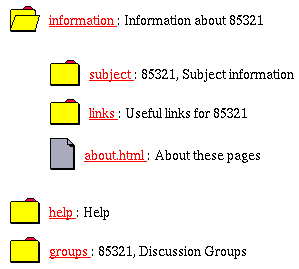 |
Producing a hypermedia text book. A previous experiment with placing a chapter of a study guide on the WWW, feedback from students, and personal use of the WWW led to the development of a number of characteristics for the 85321 hypermedia text book. These included providing full use of the hypermedia capabilities of the WWW, making it simple to print, and providing capability for inclusion of a table of contents and of an index.
When completed, the 85321 hypermedia textbook included over 900 individual WWW pages. Producing and maintaining a large collection of WWW pages that also exhibit the above characteristics is extremely difficult and time consuming. When a search for an appropriate authoring tool was unsuccessful, a Perl script was written.
Each chapter of the 85321 textbook was written as a single HTML file. Special tags were used to:
1. Divide a chapter into sections,
(SECTION TITLE="the title" --> <!--/SECTION -->
2. Divide each section into a number of pages,
<!-- PAGE TITLE="the title " --> <!-- /PAGE-->
3. To indicate the location of a term to index, and
<A NAME="INDEX_item to index">
4. Link to a particular page.
<A HREF="#page title">
Once written, each chapter was run through the script, which produces a table of contents; a copy of the chapter divided into many small WWW pages, all cross-linked; a copy of the chapter, as a single WWW page ready to be printed; and an index, for all chapters in the study material.
The look and feel of the pages are controlled by two files, header.asp and footer.asp. By modifying these files, it is possible to generate an entirely different look and feel without modifying the original chapter.
Communication. A major requirement for 85321 was simple and effective communication and collaboration between small groups of students. This requirement could have been supported by a number of different Internet applications. Due to problems with other Internet communication mechanisms, for 85321 we decided to use mailing lists. Systems not considered included:
A further advantage of mailing lists is that mail clients, like Eudora, allow students to reduce costs by reading and replying to e-mail offline. The 1996 offering of 85321 used 11 mailing lists; one list was used for all students in the subject. The remaining 10 were used for individual small groups. The mailing lists were managed by Majordomo. Hypermail was used to produce WWW based archives of discussions on each list.
Assessment. Time needed for distance students to submit and return assignments depends on the speed of the postal service. Electronic mail and its instantaneous delivery is an obvious method for reducing turnaround time. Experience in the 1995 offering of 85321 showed that simply using e-mail for assignment submission could increase the workload of the professor and not provide any considerable reduction in turnaround time.
In second semester 1995 we developed an automated management for the submission of assignments via e-mail. The procedure has several steps.
Problems. This system only automates the submission and return process. It does not address the problem of marking assignments in an electronic form. A major problem encountered with the system was the plethora of formats students used to submit assignments, including different encoding methods (e.g., MIME, binhex, uuencode) and different word processor formats.
A direct result of the immediate delivery of assignments is that students expect the assignments to be marked immediately. Previously a marker would wait until a large collection of assignments had been received before marking. Marking methods will have to change to suit the medium.
Advantages. The WWW allows students to compare their progress with other students. In addition, the WWW results page contains the number of assignments submitted and returned, and the lowest, highest, and average marks for each assignment. So, for example, students can now find out whether 9 out of 15 is a good or a bad mark. Use of WWW also results in reduced cost in handling print-based assignments, immediate acknowledgment of safe assignment receipt, and increase in overall speed of submission.
Future work. Plans for improvements include: (a) integrating automated marking of multi-choice, true/false, and other simple assessment methods; (b) use of digital signatures and encryption to increase the security of the process; (c) use of the new form-based file upload supported by Netscape 2.0 for submission of assignments;(d) an improved interface to allow simple modification of results; and (e) means of addressing the problem of how to mark and annotate on-line assignments.
Other tools. In implementing 85321, some of the existing tools available on the Internet included Majordomo, Hypermail, and FFW (the search engine).
Was It a Success?
Towards the end of the semester we placed an initial feedback form on the WWW and encouraged students to complete it. At the time of writing this paper, 45 students had responded, including 35 distance and 10 on-campus students.
Some results of the feedback. Of those who responded, 28% of students did not print the textbook, 64% of students felt lost, 87% of the students paid less than $5 an hour for Internet access,76% of students accessed the Internet from home.
We summarized students' responses in the figures below. Figure 3 shows the responses to the statement: "I needed more help at the start of the subject on how to use the Internet"; Figure 3 shows the responses to the statement: "The new approach in 85321 is better than the normal learning method."
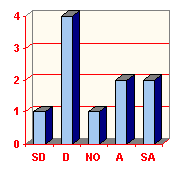 |  |  |
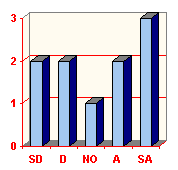 | 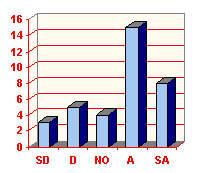 | 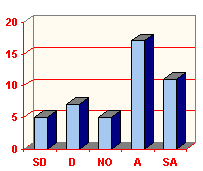 |
Free form comments from students have included:
The feedback identified and reinforced a number of problems with the implementation including textbook availability and limited flexibility. Each chapter of the 85321 textbook was not available until the beginning of the week in which it was used, due to the fact that it was being written during the semester. This meant distance students could not work ahead, a major problem.
There were problems concerning printing the textbook; indications of need for more Internet training and for tips on how to use the 85321 systems and how to enable group work. Group participation raises a number of problems especially in distance education; a number of strategies to enable group work need implementation. The 85321 class has a large initial learning curve; the 85321students must install Linux and become familiar with using the Internet before they can even begin studying. To the uninitiated, these are very significant tasks and a number of students may have dropped out because of this early difficulty.
Observations
Natives versus the immigrants. John Perry Barlow (1996), talks about cyberspace natives and cyberspace immigrants. This apt categorization of people applies to students, teachers, support staff, and management. Students who are cyberspace natives obtain immense pleasure and advantage from the 85321 teaching method. Cyberspace immigrants must struggle and strain before seeing any benefits.
The 85321 student who obtained the most benefit from the on-line learning approach can be characterized as being familiar with the Internet, having simple, cheap Internet access without any problems, and being comfortable with independent learning.
The group of students who had the most difficulty with the on-line learning approach were on-campus students. Although on-campus students generally had simple, free Internet access, many were not familiar with the Internet and were not familiar or comfortable with independent learning.
It has been said that anyone over 25 is a cyberspace immigrant; that includes almost everyone at above lecturer level. Thus, people making the decisions at universities have no idea of the impact of on-line learning or the revolutionary changes necessary to make on-line learning happen. This is the single biggest factor holding back on-line learning.
You can't please all of the people. Different people have different tastes, different backgrounds, and different learning styles, network connections with different speeds and WWW browsers with different capabilities. A WWW page that looks good to one person might look horrible to another, be too slow to load or use HTML not supported by another person's browser. WWW style is subjective and what good WWW style is depends on who you are. The fact that there is no one WWW style that is the best is lost on many people.
It's a lot of work. Development of the new 85321 teaching method was part of normal duties, with no additional funding or official assistance. A number of people did, however, volunteer their time and energy. I fulfilled the tasks of content specialist, aided by generous and steadfast help in the realms of technical support, programming, instructional design and teaching roles, with some additional teaching assistance provided during the semester.
Conclusions
University education, in both on-campus and distance modes, suffers from a number of problems. The first semester 1996 offering of the CQU subject 85321 used an on-line, collaborative learning approach in an attempt to address these problems. The use of the WWW and the Internet are particularly appropriate, due to the nature of the subject and the characteristics of the students and the teacher.
The advantages of collaborative, on-line learning are well-documented (Harasim 1990; Davie & Wells 1991). However the problems of the restriction to text, the requirement of training staff and students, and the question of equity presented hurdles. This more recent experience in 85321 has shown that the development of user-friendly, GUI-based Internet applications, the widespread availability of Internet access, and growing student familiarity with the Internet have addressed these problems, but not entirely solved them.
Early indications are that the 85321 learning approach provides significant advantages over traditional teaching methods. This is especially true for distance education. On-campus students struggled with the new learning approach, but this can be attributed to their lack of familiarity with independent learning.
If the use of on-line learning is to become widespread, there must be significant change in the funding, organization, skills, and methods used in university education.
References
Barlow, J. P. (1996). A Cyberspace independence declaration. Available HTTP: http://www.eff.org/barlow.
Buchanan, R. & Farrands, P. (1995, December). Can simulations help students understand programming concepts--A case study. Learning with technology: The Twelfth Annual Conference of the Australian Society for Computers in Learning in Tertiary Education. (pp 50-56). Melbourne.
Caladine, R. (1993). Overseas experience in non-traditional modes of delivery in higher education using state-of-the-art technologies: A literature review. Department of Employment, Education, and Training, Occasional paper series.
Candy, P., Crebert, G., & O'Leary, J. (1994). Developing lifelong learners through undergraduate education. NBEET Commissioned Report 28. Canberra: Australian Government Publishing Service.
Comber, T. (1995). Building usable Web pages: An HCI perspective, proceedings of AusWeb95.
Davie, L. & Wells, R. (1991). Empowering the learner through computer-mediated communication. American Journal of Distance Education. 5(1). (pp 15-23).
Florini, B. (1990). Delivery systems for distance education. In Michael Moore (Ed.), Contemporary issues in American distance education (pp 227-289).Oxford, UK: Pergammon Press,
Harasim, L. (1990) . Online education: An environment for collaboration and intellectual amplification . In Linda Harasim (Ed.), Online education: Perspectives on a new environment (pp 39-64). New York: Praeger.
Jones, D. (1995). 1000 Users on a 486. Proceedings of AUUG'95 and Asia-Pacific World Wide Web '95 Conference, Sydney. 105-120.
Jones, D. (1996). Computing by distance education: problems and solutions, Integrating Technology into Computer Science Education. Association for Computing Machinery (pp 139-146). Barcelona: Gordon Davies.
Kappe, F. (1996). The need for second-generation hypermedia systems. In H Maurer (Ed.), Hyper-G is now HyperWave the next generation Web solution. (pp 88-102). New York: Addison-Wesley.
Laurillard, D. (1993). Rethinking university teaching: A framework for the effective use of educational technology. New York: Routledge.
Laszlo, A. & Castro, K. (1995). Technology and values: Interactive learning environments for future generations . Educational Technology, 35(2), 7-13.
Mason, R. & Kaye, T. (1990) . Toward a new paradigm for distance education. In Linda Harasim (Ed.), Online education: perspectives on a new environment. (pp. 15-38). New York: Praeger.
Nielsen, J., & Sano, D. (1996). SunWeb: User interface design for Sun Microsystem's internal Web. Available HTTP: http://www.sun.com/sun-on-net/uidesign/sunweb/.
Nipper, S. (1989). Third generation distance learning and computer conferencing . In Robin Mason and Anthony Kaye (Eds.), Mindweave: Communication, computers and distance education. Oxford, UK: Pergamon Press.
Redkedal, T. (1983). Enhancing student progress in Norway. Teaching
at a Distance 23, 19-24.
